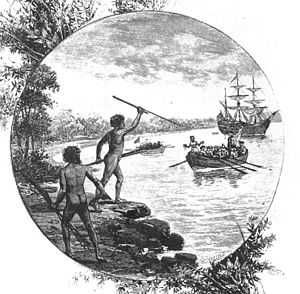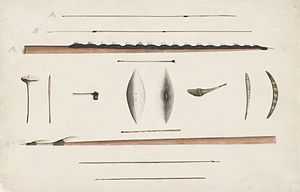Gweagal

The Gweagal (also spelt Gwiyagal) are a clan of the Tharawal (or Dharawal) tribe of Indigenous Australians, who are traditional custodians of the southern geographic areas of Sydney, New South Wales, Australia.[1]
The Gweagal lived on the southern shores of Botany Bay (Kurnell Peninsula). The tribe territory, although not clearly defined, spanned the areas between the Cooks and Georges River, south to the Port Hacking estuary and westwards towards Liverpool. They were the northernmost tribe of the Dharawal nation.[2]
Culture

Each Gweagal tribe consisted of approximately 20 to 50 people who lived in their own territory amongst social and economic units having strong ties to land and sacred sites. They had no written language and each tribe had its own dialect, they also knew how to light fires long before the arrival of Europeans. They were often seen by early settlers to be naked but with minimal clothing that consisted of a woven hair sash in which they used to carry tools and weapons and sometimes the optional possum-skin coat for the winter season. They wore resin in their hair that gave it a mop-like appearance and used native animal hide to make fur coats and ceremonial attire. Tool makers chose to grind axes close to pools or streams, as the water was used as a lubricant for grinding and sharpening. The stone that was used was mainly igneous or metamorphic rock, and only one of the ends was ground to a blade. Axe grinding grooves used in for this purpose can be found near a stream between River Road and Salt Pan Creek at Revesby Heights. In 1961 a notice was erected describing the site.[3]
The Gweagal Aborigines were the guardians of the sacred white clay pits in their territory. Members of the tribe walked hundreds of miles to collect the clay, it was considered sacred amongst the indigenous locals and had many uses. They used it to line the base of their canoes so they could light fires, and also as a white body paint, (as witnessed by Captain James Cook). Colour was added to the clay using berries, which produced a brightly coloured paint that was used in ceremonies. It was also eaten as a medicine, an antacid. Geebungs and other local berries were mixed in the clay and it was eaten as a dietary supplement with zinc. [4][5]
Aboriginal rock shelters
.jpg)
Caves in the form of over hanging rock shelters were an important part of the Aboriginal lifestyle, they had no modern dwellings in which to live so they often used caves or overhanging rocks as dwelling places and for burial sites. In the Royal National Park some of the caves were used as burial sites.
Caves and shelters are located in various places along the George's River, which over the years have eroded into the sandstone cliffs. There is a large cave located in Peakhurst with its ceiling blackened from smoke. There are caves located around Evatt Park, Lugarno with oyster shells ground into the cave floor. A cave has also been discovered near a Baptist church in Lugarno, and another near Margaret Crescent, Lugarno (now destroyed by development), it was found to contain ochre and a spear head on the floor of the cave when it was excavated. Another cave exists on Mickey's Point, Padstow, which was named after a local aborigine.[6]
They often decorated their caves and rock shelters with paintings, drawings and etchings using white, red and other colored earth, clay or charcoal. In winter they shared body heat in the shelter and used fire to keep warm.
Food source
The territory of the Gweagal had much to offer. The Georges River provided fish and oysters. Various small creeks, most of which are now covered drains, provided fresh water. Men and women fished in canoes or from the shore using barbed spears and fishing lines with hooks that were crafted from crescent-shaped pieces of shell. Waterfowl could be caught in the swamplands near Towra Point and the variety of soils supported a variety of edible and medicinal plants. Birds and their eggs, possums, wallabies and goannas were also a part of their staple diet. The abundant food source meant that these natives were less nomadic than those of Outback Australia.
Middens
Middens have been found all the way along tidal sections of the Georges River where shells, fish bones, and other waste products have been thrown into heaps. This gives evidence of where Aborigines camped for long periods, and are found where oysters, fresh water, and strategic views come together. Middens have been found in Oatley, and Oatley Point was known as a feasting ground. In Lugarno a midden is still existent and may be found in Lime Kiln Bay.
First contact with Europeans
The Gweagal Aborigines made first contact with James Cook and other Europeans, occupying the area which is now 'Captain Cooks Landing Place Reserve’, Kurnell, on the shores of Botany Bay. It was in this place that the crew of Captain Cook’s first voyage tried to make contact with the indigenous people of Australia.
For eight days between late April and early May 1770, Cook’s ship the 'Endeavour' was anchored in the bay. Sir Joseph Banks stated that some of the Aborigines withdrew into the bushes as the Endeavour came near. Several warriors remained on the rocks, "threatening and menacing with their pikes and swords". When Cook and his crewmen tried to land, two of the tribesmen stood on the rocks, warning them off with spears and sticks. After about 15 minutes there was an exchange of musket fire and spears. One shot wounded a local man in the leg, no harm came upon Cook's crew.
The sailors then proceeded to walk onto the beach and up to an encampment. Both Cook and Banks tried, with great difficulty, to make contact with the local people but without success due to the Aborigines avoiding contact after the first encounter, they simply went about their daily affairs seeming to ignore the strangers; they fished from canoes, cooked shellfish on the shore, walked along the beach, but at the same time, watched Cook’s crew with caution. There were a few cases where, Gweagal men tried to approach members of Cook’s expedition, before shying away. In all of their responses, the locals sought to deal with them in a way that would allow them “to affirm their rights to their land and their resources and defuse any potential conflict or hostility."[7][8][9]
Artefacts from Cook's and Banks' encounter
In 1770, after returning to England from their voyage in the South Pacific, Cook and Banks brought with them a large collection of flora and fauna, along with cultural artifacts from their most recent venture. The find included a collection of roughly fifty Australian Aboriginal spears that were owned by the Gweagal people.
Banks was convinced the spears were abandoned (on the shores of Kurnell) and "thought it no improper measure to take with them all the lances which they could find, somewhere between 40 or 50".
Four of those spears - the only material reminders of the first meeting between Aborigines and Englishmen on the east coast still exist: two bone-tipped three-pronged spears, one bone-tipped four-pronged spear and a shaft with a single hardwood head. Cook gave the spears to his patron, John Montagu, First Lord of the Admiralty and Fourth Earl of Sandwich, who then gave them, to his alma mater Trinity College. Archaeologists quote them as being priceless, as the spears are among the few remaining artefacts that can be traced back to Cook's first voyage. Although the spears remain in the ownership of Trinity, they are now on display at the Museum of Archaeology and Anthropology of Cambridge University in England.[8][10]
| Wikimedia Commons has media related to Australian Aborigines. |
References
- ↑ Aussie People - Aborigines
- ↑ Kurnell - A Pictorial History
- ↑ Lawrence, Joan.; Brian Madden and Lesliie Muir. (September 1999). http://www.kingsclearbooks.com.au/cb.html Pictorial History of Canterbury Bankstown. Kingsclear Books. pp. Page 2. ISBN 0-908272-55-3. .
- ↑ Gweagal
- ↑ Pictorial Memories ST. GEORGE: Rockdale, Kogarah, Hurstville Joan Lawrence, Kingsclear Books, 1996
- ↑ Aussie People - Aborigines
- ↑ A place of encounters - A short history of Botany Bay National Park - Kurnell section
- ↑ 8.0 8.1 "Once were warriors". The Sydney Morning Herald. 11 November 2002.
- ↑ Indigenous people - Botanic Gardens Trust - Sydney, Australia
- ↑ Radio National Breakfast - 13 November 2002 - Cook's Spears
| ||||||||||||||||||||||